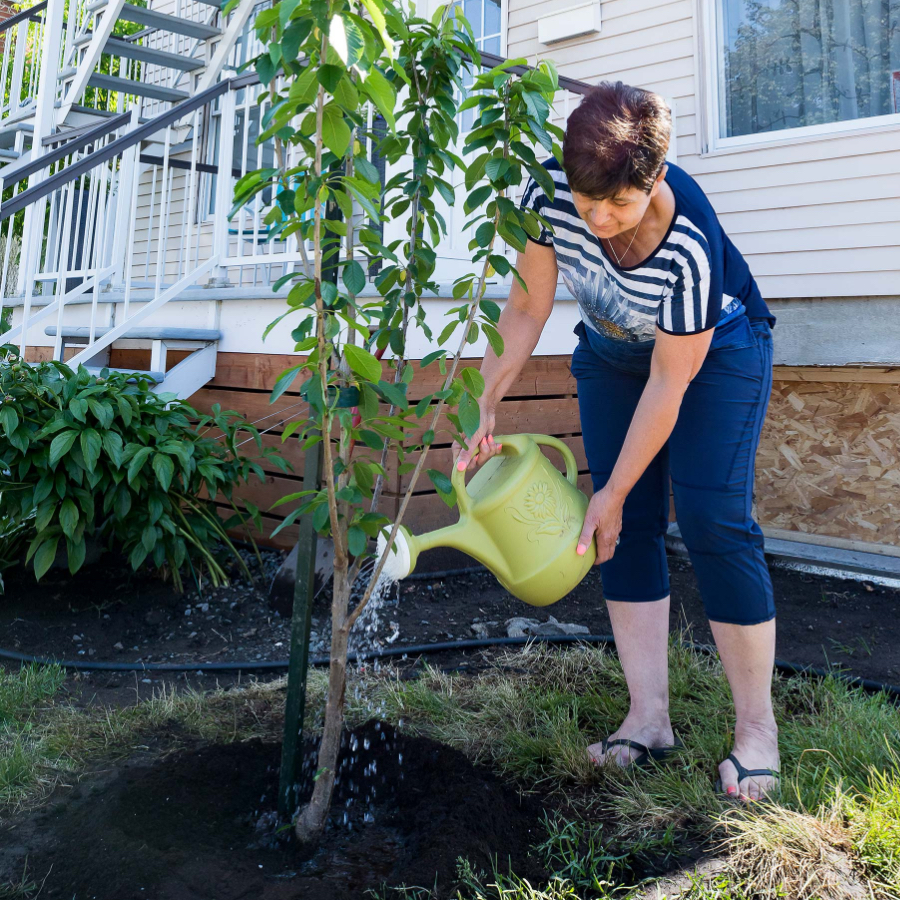Planting a tree is great for the environment and for future generations.
Once established, a tree doesn’t require particular care. However, a young, newly planted tree requires some care while it establishes roots in the soil so it can survive the first two years of its life.


Watering
Water daily for the first two weeks after planting. Water generously, including the entire area under the tree canopy. If your soil does not drain well, you can water gradually to prevent runoff. Make sure not to overwater. If water pools around the tree or if the soil is extremely wet after watering, water less often.
After the first few weeks and for about two years, it’s better to water deeply but less frequently (every two or three days) than to give your tree a small amount every day. By watering deeply, we mean watering for several minutes!
However, young trees need to be watered more frequently during dry periods. The best time to water is in the morning or evening so that the roots can absorb most of the water.
In the fall, pay special attention to conifers and evergreens that need to store water for the winter. Water regularly and abundantly before the first frost.
STAKing
We recommend adding a stake when the tree is planted in a very windy place or on steeply sloping ground, if the tree is poorly rooted or if it is planted somewhere where it is likely to be knocked into.
If you are using a stake, be sure to:
• plant it outside the root ball;
• install it facing the prevailing winds;
• make sure that the straps are not too tight;
• remove it after one year.

Weeding
Weeding around small trees is essential and ensures that young trees get enough sunlight and space and don’t have to compete for soil nutrients.
Mulching
Mulch serves several functions: it retains moisture, suppresses weeds, moderates swings in soil temperature, provides nutrients and organic matter as it decomposes, protects trunks from lawn mowers and roots from the cold if snow cover is insufficient, houses useful organisms and improves the health of the soil.
Use organic mulches (ramial chipped wood, shredded bark (such as cedar or hemlock mulch), wood chips, forest mulch, etc.).
Apply about 10 to 15 cm of mulch at the base of the tree, staying clear of the trunk itself.
Fertilizing
In general, using potting soil (purchased at a garden centre) and adding compost, mycorrhizal fungi or any other amendments when planting your tree will provide your tree with everything it needs. Eventually, it will find all the nutrients it needs in the existing soil. We don’t recommend adding fertilizer.
Pruning
In general, trees purchased in nurseries have already been pruned to develop a single central trunk and branches that are well arranged. If you must prune some broken or badly positioned branches, we recommend doing so before planting, since it is easier to access the top of the tree. For more complex pruning, we recommend hiring an expert to make cuts that do not damage the tree and will encourage its growth
PROTECTing FOR WINTER
To protect the roots of your tree during winter, cover the base of the tree with snow. For the first three to five years, we also recommend installing a rodent protector in the fall and removing it in the spring.
observing for winter
To avoid unpleasant surprises, it is important to keep a close eye on your tree. Have the leaves changed colour or do they appear damaged? Are there larvae or insects on your tree? These could be signs of disease or problematic insects.
Don’t panic! Just like us, trees sometimes get sick. With proper care and treatment, your tree will quickly get better.
If in doubt, ask for advice at your garden centre or consult https://espacepourlavie.ca/carnet-horticole-et-botanique
